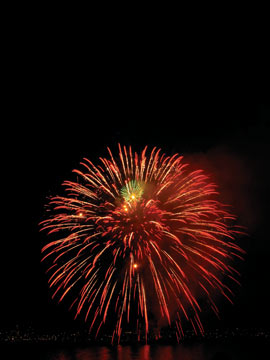|
NEWS NOTES
Mineral resource of the month: strontium
| Strontium gives fireworks their bright red colors. |
Joyce A. Ober, mineral commodity specialist for the U.S. Geological Survey, has compiled the following information on strontium, the material that gives fireworks their brilliant reds.
Last month as Americans sat transfixed watching fireworks on July 4, they were probably unaware that strontium was responsible for the beautiful reds in the display. Strontium, a soft silver-white or yellowish metallic element that turns yellow when exposed to air (and red when it burns), is prized for its brilliant red flame. Because it reacts with air and water, the metal is only present naturally in compounds, such as celestite and strontianite.
Celestite, or strontium sulfate, is the most common strontium mineral. Huge deposits of high-grade celestite have been identified throughout the world — but 96 percent of it comes from just four countries: China, Mexico, Spain and Turkey. In most instances, commercial celestite deposits are mined from remote, undeveloped locations far from population centers, where inexpensive labor is available. Because removing impurities from celestite is often difficult and energy-intensive, strontium chemical producers require that raw materials contain at least 90 percent strontium sulfate.
Still, very little strontium is consumed directly as celestite. It is usually converted to strontium carbonate through a chemical process. Strontium carbonate is used directly in some applications, such as television glass, and is also converted into the appropriate downstream chemicals for other end uses.
For many years, the most important use of strontium, accounting for about 75 percent of the market, was in the production of faceplate glass for color cathode ray tubes (CRTs) to block X-ray emissions from CRTs used in televisions, computer monitors and other electronic devices. But this has decreased dramatically as flat panel displays, which use little to no strontium, have replaced CRTs. The last TV glass plant in the United States closed in 2006. The demand for CRTs has declined in other developed countries as well, but is going strong in Asia, especially in India and China.
Today, pyrotechnics and signals — fireworks and flares — and ferrite ceramic magnets have become the most important strontium markets. The metal gives off a brilliant red flame when it burns. Strontium ferrite magnets have a variety of applications, including in small direct current motors, loudspeakers, toys and other electronic equipment.
Although demand for strontium compounds in the United States only fell 5 percent from 2006 to 2007, demand has fallen 78 percent since 1997, primarily because the compounds are no longer used in TVs. The demand decrease has probably leveled off, however. Materials like barium can replace strontium in some of its uses, such as in ferrite ceramic magnets, but the replacement would adversely affect product performance and cost. And substituting for strontium in pyrotechnics would be impractical because the desired brilliance and visibility imparted by strontium and its compounds are superior to those of possible substitutes. So although demand has fallen in CRTs, it is unlikely to fall for these other uses.
For more information on strontium, visit http://minerals.usgs.gov/minerals.
Links:
uncleweed.net

 Subscribe
Subscribe



